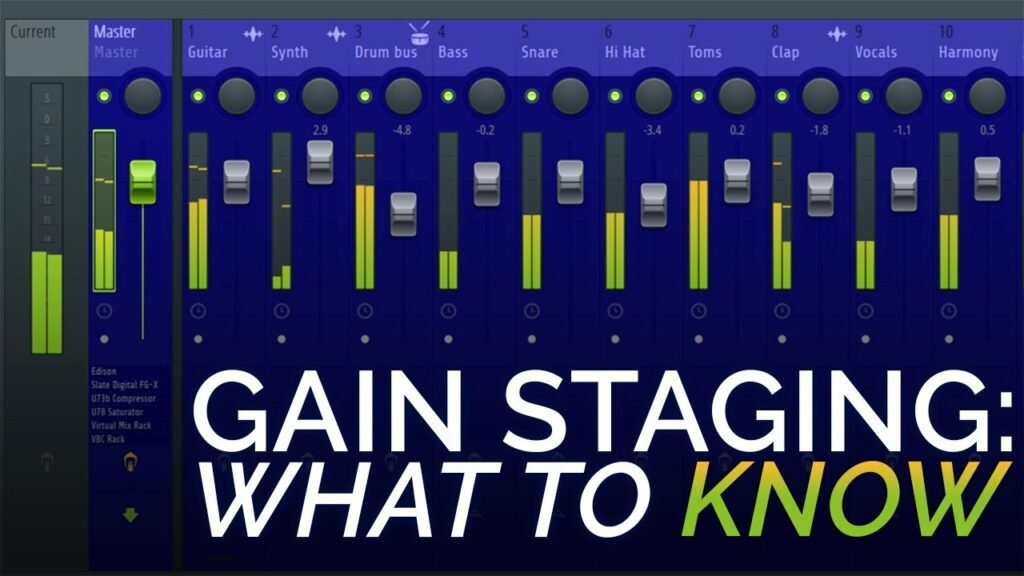
there seems to be a lot of confusion about what gain staging is I ’ve had a lot of dispatches and I ’ve also transferred a lot of people on forums online relatively confused I ’m Michael you ’re watching in the blend and moment we ’re going to be participating with you three guidelines that we follow in every single song just to keep us on track with gain staging as far as I ’m concerned gain staging is each about having the right signal position at all points in your chain whether you ’re working in analog or digital this is still important for numerous different reasons but the analog side of effects is important to make sure you record at the right position blend at the right position master at the right position so that you do n’t dodge access vid noise press hum and just sort of unwanted noise in general and for the digital world where utmost of us are working these days it’s still important indeed though you do n’t have to deal with any of the noise any of the hiss and any of the hum convinced by analog tackle the guidelines in this videotape are each about keeping you on the right track avoiding unwanted trimming and making sure that your situations are each good the first one is about not trimming the mixbus the alternate bone is about feeding your plugins at the right volume so that they ’re working and they do n’t distort and they ’re given the right kind of energy and the third guideline is about how to optimize your fader position for the stylish resolution possible like I said the first part is each about making sure you do n’t crop your
mixbus we ’re always told to leave Headroom in a blend so that you can master it so there’s no trimming and deformation and all feathers of stuff but how do you actually give yourself Headroom well if your blend is trimming stylish place to start is to just snare all of the faders and just pull them down slightly until it’s no longer trimming or you could identify a source that’s too loud frequently bass or a kick barrel just has an awful lot of energy and can push through the blend and beget it to clip so the first thing to do would be to pull down the faders and get relieve of that trimming from the star once your blend is not Trimming what you want to do is make sure that your plugins are working at the right volume this is a content that most newcomers sort of are n’t apprehensive of but it’s actually really easy to grasp lots of plugins especially analog modeled plugins don't respond in a direct manner they've a nonlinear response and what this means is that when you input a different quantum of signal they bear in veritably different ways if you input too important signal they distort if you do n’t input enough signal they just do n’t have the good goods that you them to have there’s frequently a good range of volume that you want to be feeding into these plugins and generally this is about minus 18 DB although this is just a guideline and anywhere in that kind of range is okay now the way that we achieve this is to put a game unit at the launch of every single goods change we like to use the slate digital trimmer because it has an affair in vu and in DB and it just helps us get everything in the right ballpark we know that when the vu cadence is swimming around about zero we ’re
getting the right kind of energy out of them and also to make sure that we ’re not erecting up too important volume we just make sure that we turn the affair of each VST down so that when we bypass it the volume stays around about the same and this way you ’re not just adding loads more gain and potentially trimming your blend machine which would take us back to step one there are some plugins that do respond in a direct manner and if that’s the case also it does n’t count what volume you feed into them and feeding-18 DB into them wo n’t harm them the third part is each about optimizing your fader position so occasionally in our old composites we used to have the faders veritably low and I did n’t really suppose much of this at the time but what it did is remove my capability to make veritably fine changes fluently you see if your fader is at the top around about zero or concinnity you have a lot of control you can move it quite a lot and it’s only moving a DB or so but if you drag it all the way down if you start
moving it a little bit you start jumping in two or three five DB at a time so you lose a lot of control there the problem is if you ’ve gain stage right through your goods turning up all the way to zero might just make it far too loud so what you can do is put a gain unit at the end of the effect chain so now we've one at the launch and one at the end what you could do is take say 15 DB of gain down and also push your fader up 15 DB get it close to zero and your fader will have lots of resolution and your goods will be running at all the right volume and you wo n’t be trimming your mixbus and those are the only three guidelines that we suppose are important when you ’re working inside the D aw there’s one little myth that I ’d like to clear up in a moment but when it comes to working inside the door super easy way to achieve it it’s just to put it gain unit at the launch of your goods chain and it at the end and just use those to control the situations into your plugin and the position hitting your fader and also the position in your blend machine the one thing that I just wanted to clear up that I ’ve read online people were saying that if you do that and you take gain down and also push the fader up people are saying that you ’ll induce a lot of major into the recording and in a digital audio workstation unless there’s a fault this simply is n’t gon na be you ’re not pulling a noise bottom over in a da w utmost dear w’s do n’t have any kind of audible noise bottom whatsoever the way you would have with the vid machine or an analog press and to
demonstrate this I ’ve taken a guitar recording and I ’ve removed gain Also I ’ve published it out and exported it also I ’ve added gain with the fader exported it I ’ve done this process 20 times and also I ’ve position matched it and you ’ll be suitable to hear the one with zero processing and also the bone that’s had gain added and removed 20 times and you ’re hear that there’s absolutely no difference in the noise bottom hiss hum buzz in the sample it’s simply not commodity you need to worry about so hopefully this videotape has clarified a little bit about gain staging I hope it’s simplified it in your mind and it’s not commodity that you ’re stressing about presently da w’s do make gain staging veritably veritably easy these days if anyone would like me to make a videotape showing how we gain stage specifically inside FL Studio I can make that videotape just leave a comment down below and we ’ll see about making it if you did enjoy this videotape or plant it helpful please do leave a suchlike and subscribe it helps us out enormous ly thank you veritably much for watching I ’ll see you in the coming Check Plagiarism Check Grammar Your valuable





